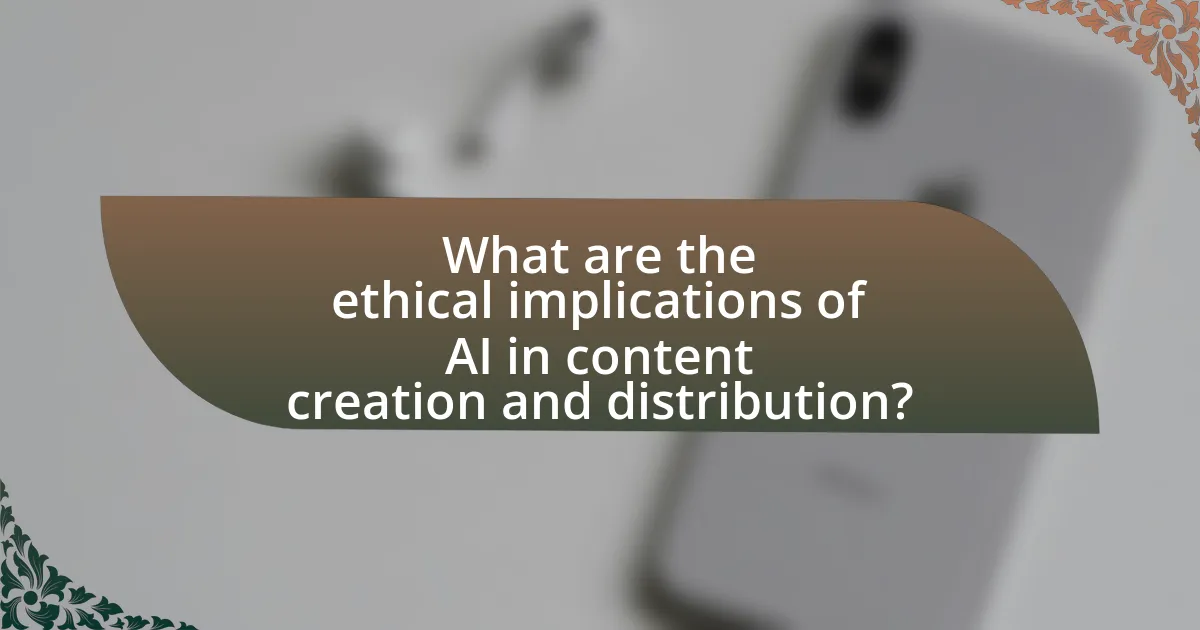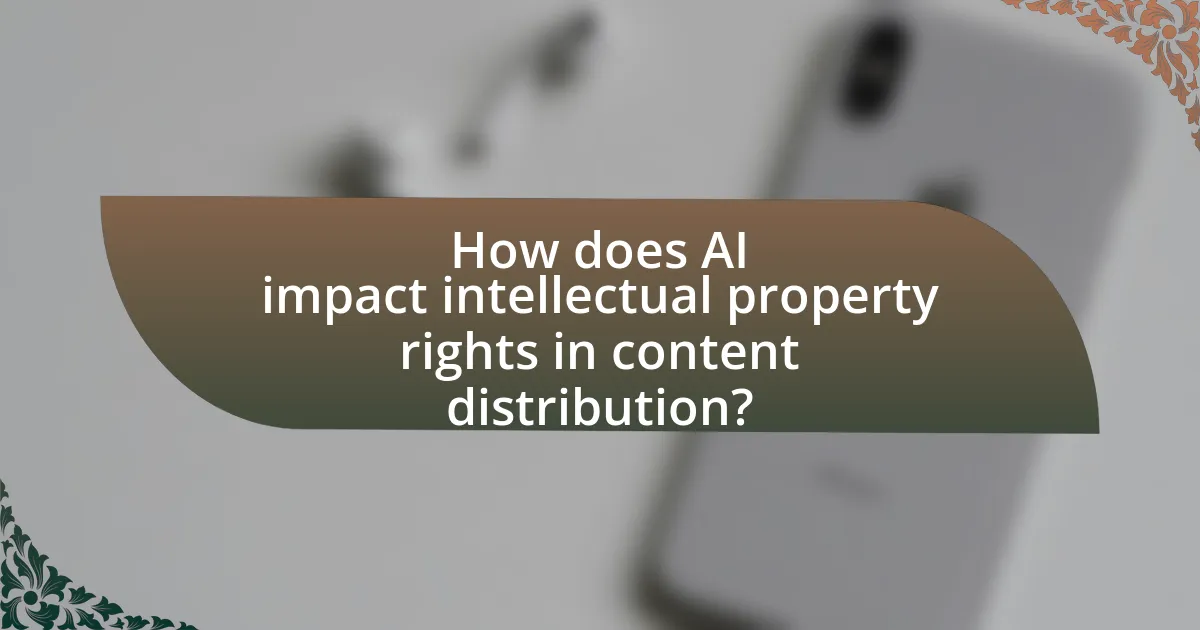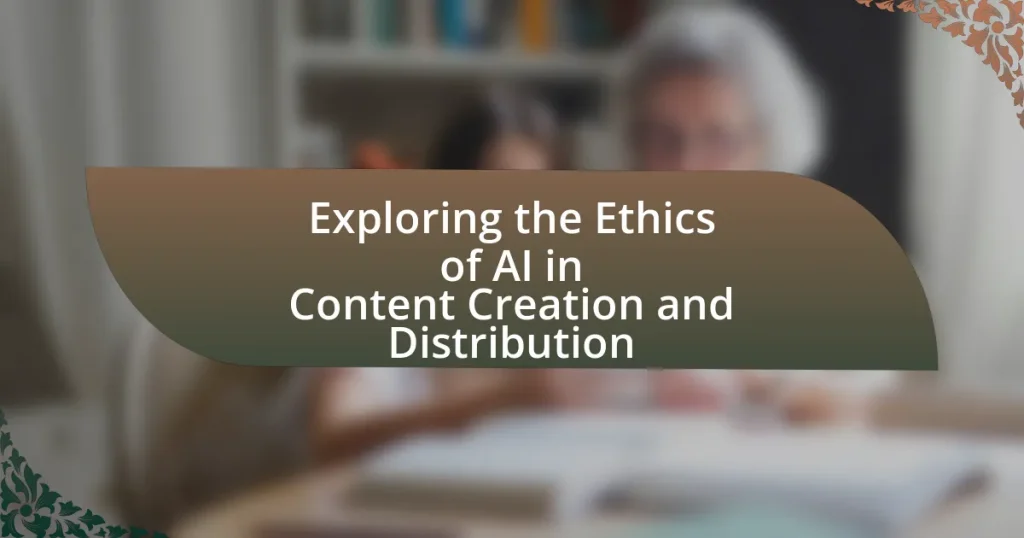The article examines the ethical implications of artificial intelligence (AI) in content creation and distribution, addressing critical issues such as misinformation, copyright infringement, and algorithmic bias. It highlights the risks associated with AI-generated content, including the potential for spreading false narratives and the challenges posed to intellectual property rights. The discussion also covers how AI influences content authenticity, the importance of transparency and accountability for creators, and strategies to mitigate bias in AI systems. Overall, the article emphasizes the need for ethical guidelines to navigate the complexities introduced by AI in the digital landscape.

What are the ethical implications of AI in content creation and distribution?
The ethical implications of AI in content creation and distribution include concerns about misinformation, copyright infringement, and the potential for bias. Misinformation can arise when AI generates content that is misleading or false, impacting public perception and trust. Copyright infringement occurs when AI uses existing works without proper attribution or permission, violating intellectual property rights. Additionally, bias in AI algorithms can lead to the perpetuation of stereotypes or discrimination, as these systems may reflect the prejudices present in their training data. According to a 2021 study by the AI Now Institute, 80% of AI systems exhibit some form of bias, highlighting the need for ethical oversight in AI development and deployment.
How does AI influence the authenticity of content?
AI influences the authenticity of content by enabling the generation of highly realistic but potentially misleading information. For instance, AI algorithms can create deepfakes or synthetic media that mimic real individuals, which can lead to the spread of false narratives. Research from the MIT Media Lab indicates that deepfake technology has advanced to the point where it can produce videos indistinguishable from genuine footage, raising concerns about trust in visual media. Additionally, AI-driven content creation tools can produce articles and reports that may lack the nuanced understanding of human authors, leading to questions about the reliability of such content.
What are the risks of misinformation in AI-generated content?
The risks of misinformation in AI-generated content include the potential for spreading false information, undermining public trust, and influencing harmful behaviors. AI systems can generate content that appears credible but is factually incorrect, leading to the dissemination of misleading narratives. For instance, a study by the MIT Media Lab found that false news spreads six times faster than true news on social media platforms, highlighting the rapid propagation of misinformation. Additionally, AI-generated content can manipulate public opinion, as seen in political campaigns where misleading information can sway voter behavior. These risks necessitate stringent oversight and ethical guidelines in AI content creation to mitigate the impact of misinformation.
How can AI-generated content be distinguished from human-created content?
AI-generated content can be distinguished from human-created content through specific linguistic patterns, coherence levels, and contextual understanding. AI often produces text with repetitive phrases, lacks deep emotional nuance, and may struggle with complex topics that require personal experience or cultural context. Studies, such as those conducted by researchers at Stanford University, have shown that AI-generated text tends to have a more uniform structure and can lack the subtlety found in human writing, which often includes varied sentence lengths and a more diverse vocabulary. Additionally, AI may fail to grasp idiomatic expressions or cultural references, making its output less relatable compared to human-generated content.
What are the potential biases in AI content generation?
Potential biases in AI content generation include algorithmic bias, data bias, and cultural bias. Algorithmic bias occurs when the algorithms used to generate content reflect the prejudices present in their training data, leading to skewed or unfair outputs. Data bias arises when the datasets used to train AI models are not representative of the diversity of the population, which can result in the marginalization of certain groups. Cultural bias manifests when AI systems favor certain cultural perspectives over others, potentially reinforcing stereotypes or excluding minority viewpoints. Research by the AI Now Institute highlights that biased training data can lead to discriminatory outcomes in AI applications, underscoring the importance of addressing these biases to ensure ethical content generation.
How do biases in training data affect AI outputs?
Biases in training data lead to skewed AI outputs, resulting in unfair or inaccurate representations of certain groups or ideas. When AI systems are trained on data that reflects societal biases, such as gender, race, or socioeconomic status, they can perpetuate these biases in their predictions or decisions. For instance, a study by Buolamwini and Gebru in 2018 found that facial recognition systems had higher error rates for darker-skinned individuals and women, demonstrating how biased training data can lead to discriminatory outcomes. This highlights the ethical implications of using biased data in AI, as it can reinforce stereotypes and exacerbate inequalities in content creation and distribution.
What measures can be taken to mitigate bias in AI content creation?
To mitigate bias in AI content creation, implementing diverse training datasets is essential. Diverse datasets ensure that the AI is exposed to a wide range of perspectives and experiences, reducing the likelihood of reinforcing existing biases. Research by Buolamwini and Gebru in the “Gender Shades” project demonstrated that facial recognition systems performed significantly worse on darker-skinned individuals and women, highlighting the importance of inclusive data. Additionally, regular audits and bias detection algorithms can identify and address biases in AI outputs, ensuring ongoing fairness in content generation.

How does AI impact intellectual property rights in content distribution?
AI significantly impacts intellectual property rights in content distribution by complicating ownership and copyright issues. The use of AI technologies, such as machine learning algorithms, can generate original content that raises questions about who holds the rights to that content—the creator of the AI, the user who prompted the AI, or the AI itself. For instance, the U.S. Copyright Office has stated that works created by AI without human intervention may not qualify for copyright protection, as seen in the case of the artwork generated by the AI program “Stephen Thaler’s DABUS.” This situation illustrates the ongoing legal debates surrounding the applicability of existing intellectual property laws to AI-generated content, highlighting the need for updated regulations to address these emerging challenges.
What challenges does AI pose to copyright laws?
AI poses significant challenges to copyright laws primarily due to its ability to generate original content that may infringe on existing copyrighted works. The automation of content creation raises questions about authorship and ownership, as AI systems can produce text, images, and music that closely resemble or replicate human-created works. For instance, when an AI generates a piece of art that is similar to a copyrighted painting, it complicates the determination of whether the AI’s output constitutes fair use or copyright infringement. Additionally, the lack of clear legal frameworks regarding AI-generated content creates uncertainty for creators and copyright holders, as existing laws were not designed to address the complexities introduced by AI technologies. This ambiguity can lead to disputes over intellectual property rights, as traditional definitions of authorship do not easily apply to non-human creators.
How can creators protect their work in an AI-driven landscape?
Creators can protect their work in an AI-driven landscape by utilizing copyright laws, implementing digital rights management (DRM), and leveraging blockchain technology for ownership verification. Copyright laws provide legal protection against unauthorized use, allowing creators to enforce their rights and seek remedies for infringement. Digital rights management tools help control access and distribution of digital content, ensuring that creators can restrict how their work is used. Additionally, blockchain technology offers a decentralized method for verifying ownership and tracking the use of creative works, which can deter unauthorized reproduction and enhance transparency. These strategies collectively empower creators to safeguard their intellectual property in an evolving digital environment.
What are the implications of AI-generated works on ownership?
AI-generated works complicate traditional notions of ownership, as the creator of the work may not be a human but rather an algorithm. This raises questions about copyright, as current laws typically require a human author for protection. For instance, in the United States, the Copyright Office has stated that works created solely by AI without human intervention are not eligible for copyright. This creates a legal gray area where the ownership of AI-generated content may default to the entity that owns the AI or the user who prompted its creation, leading to potential disputes over rights and usage. Furthermore, the lack of clear ownership can hinder the ability to monetize such works, impacting creators and industries reliant on intellectual property.
How does AI affect the distribution of content across platforms?
AI significantly influences the distribution of content across platforms by optimizing algorithms that determine what content is shown to users. These algorithms analyze user behavior, preferences, and engagement metrics to tailor content delivery, ensuring that users receive personalized recommendations. For instance, platforms like Facebook and YouTube utilize AI-driven algorithms to prioritize content that aligns with individual user interests, which can lead to increased engagement and retention rates. According to a study by the Pew Research Center, 64% of Americans believe that algorithms significantly shape their online experiences, highlighting the pervasive role of AI in content distribution.
What role does AI play in content recommendation systems?
AI plays a crucial role in content recommendation systems by analyzing user behavior and preferences to deliver personalized content. These systems utilize machine learning algorithms to process vast amounts of data, identifying patterns that inform recommendations. For instance, Netflix employs collaborative filtering and deep learning techniques to suggest shows based on viewing history, which has been shown to increase user engagement significantly. According to a study by the Massachusetts Institute of Technology, personalized recommendations can enhance user satisfaction by up to 70%. This demonstrates that AI not only improves the relevance of content but also drives user retention and satisfaction in digital platforms.
How can AI enhance or hinder content accessibility?
AI can enhance content accessibility by providing tools that improve the usability of digital content for individuals with disabilities. For instance, AI-driven technologies like automatic captioning and text-to-speech systems enable users with hearing or visual impairments to access information more easily. According to a study by the World Health Organization, approximately 15% of the global population experiences some form of disability, highlighting the importance of these AI applications in making content more inclusive.
Conversely, AI can hinder content accessibility if algorithms are biased or if they fail to account for diverse user needs. For example, AI systems trained on non-representative data may produce outputs that are not usable for all individuals, thereby excluding certain groups from accessing information. A report from the AI Now Institute emphasizes that without proper oversight, AI can perpetuate existing inequalities, which can negatively impact accessibility efforts.

What are the ethical responsibilities of creators using AI?
Creators using AI have the ethical responsibility to ensure transparency, accountability, and fairness in their work. Transparency involves clearly disclosing the use of AI in content creation, allowing audiences to understand the role of technology in the final product. Accountability requires creators to take responsibility for the outcomes of their AI-generated content, including potential biases or misinformation. Fairness mandates that creators actively work to mitigate biases in AI algorithms, ensuring that their content does not perpetuate stereotypes or discrimination. For instance, a study by the AI Now Institute highlights that biased data can lead to discriminatory outcomes, emphasizing the need for creators to critically evaluate the datasets used in AI training.
How should creators ensure transparency in AI-generated content?
Creators should ensure transparency in AI-generated content by clearly disclosing the use of AI in the creation process. This can be achieved by labeling content as AI-generated, providing information about the AI tools used, and explaining the role of AI in the content’s development. Research indicates that transparency fosters trust; a study published in the Journal of Business Ethics found that consumers are more likely to engage with brands that openly communicate their use of AI technologies. By implementing these practices, creators can uphold ethical standards and enhance audience understanding of AI’s influence in content creation.
What guidelines can be established for ethical AI use in content creation?
Guidelines for ethical AI use in content creation include transparency, accountability, and fairness. Transparency requires that creators disclose the use of AI in generating content, allowing audiences to understand the source and nature of the material. Accountability mandates that organizations take responsibility for the content produced by AI, ensuring that it adheres to ethical standards and does not propagate misinformation. Fairness involves ensuring that AI systems are trained on diverse datasets to avoid bias, promoting inclusivity and equity in the content generated. These guidelines are supported by the increasing emphasis on ethical AI practices in industry standards, such as the IEEE Global Initiative on Ethics of Autonomous and Intelligent Systems, which advocates for responsible AI development and deployment.
How can creators balance innovation with ethical considerations?
Creators can balance innovation with ethical considerations by implementing a framework that prioritizes transparency, accountability, and stakeholder engagement. This approach ensures that new technologies and creative processes do not compromise ethical standards or societal values. For instance, the integration of ethical guidelines in AI development, such as those proposed by the IEEE Global Initiative on Ethics of Autonomous and Intelligent Systems, emphasizes the importance of human rights and fairness in innovation. By actively involving diverse stakeholders in the creative process, creators can identify potential ethical dilemmas early and adapt their innovations accordingly, fostering a responsible and inclusive environment.
What best practices should be followed when using AI in content creation?
When using AI in content creation, best practices include ensuring transparency, maintaining human oversight, and prioritizing ethical considerations. Transparency involves clearly disclosing the use of AI in generating content, which helps build trust with the audience. Human oversight is crucial to review and refine AI-generated content, ensuring it aligns with brand values and quality standards. Ethical considerations should focus on avoiding biases in AI algorithms and ensuring that the content does not mislead or harm users. These practices are supported by research indicating that transparency and human involvement enhance the credibility and effectiveness of AI-generated content, as highlighted in studies by the Pew Research Center on AI ethics.
How can creators maintain authenticity while leveraging AI tools?
Creators can maintain authenticity while leveraging AI tools by ensuring that their unique voice and perspective remain central to the content they produce. This involves using AI as a supportive tool rather than a replacement for their creative process, allowing them to enhance their work without compromising their individuality. For instance, a study by the Pew Research Center indicates that 70% of content creators believe that technology should augment human creativity, not replace it. By integrating AI for tasks like data analysis or content optimization, creators can focus on their core message and personal style, thus preserving authenticity in their work.
What strategies can be implemented to ensure ethical AI use in content distribution?
To ensure ethical AI use in content distribution, organizations should implement transparency, accountability, and bias mitigation strategies. Transparency involves clearly communicating how AI algorithms operate and the data they utilize, which fosters trust among users. Accountability can be established by creating oversight mechanisms that monitor AI decisions and their impacts, ensuring that there are consequences for unethical practices. Additionally, bias mitigation strategies, such as regular audits of AI systems and diverse training datasets, help to minimize discrimination and promote fairness in content distribution. These strategies are supported by research indicating that transparency and accountability significantly enhance user trust and satisfaction in AI applications (Source: “The Ethics of AI and Big Data,” authors: Kate Crawford and Ryan Calo).




